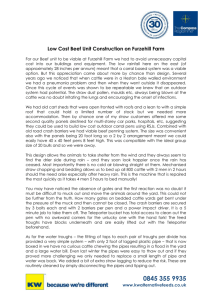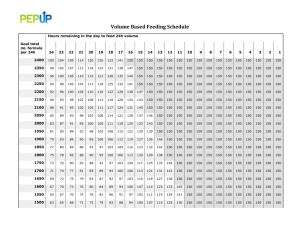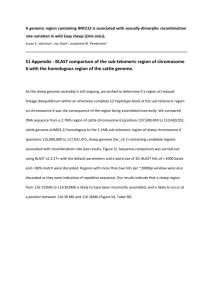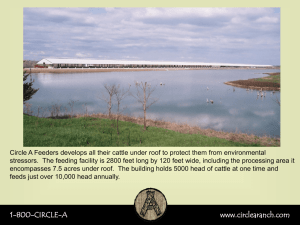Stock Containment Areas Fact Sheet [MS Word
advertisement
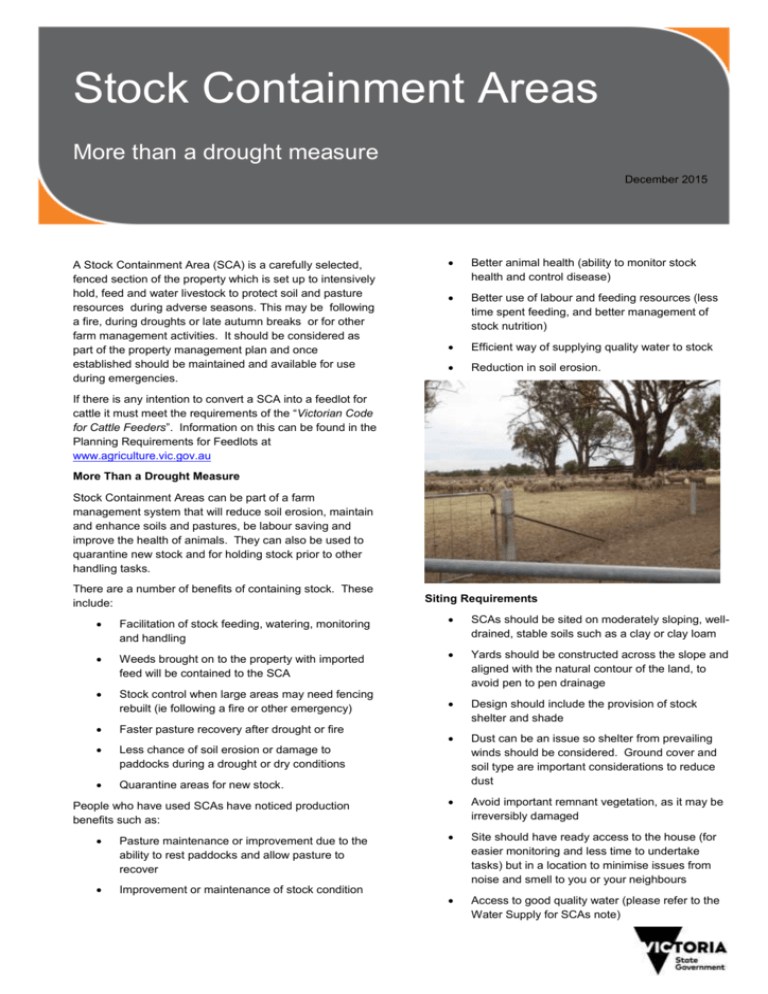
Stock Containment Areas More than a drought measure December 2015 A Stock Containment Area (SCA) is a carefully selected, fenced section of the property which is set up to intensively hold, feed and water livestock to protect soil and pasture resources during adverse seasons. This may be following a fire, during droughts or late autumn breaks or for other farm management activities. It should be considered as part of the property management plan and once established should be maintained and available for use during emergencies. Better animal health (ability to monitor stock health and control disease) Better use of labour and feeding resources (less time spent feeding, and better management of stock nutrition) Efficient way of supplying quality water to stock Reduction in soil erosion. If there is any intention to convert a SCA into a feedlot for cattle it must meet the requirements of the “Victorian Code for Cattle Feeders”. Information on this can be found in the Planning Requirements for Feedlots at www.agriculture.vic.gov.au More Than a Drought Measure Stock Containment Areas can be part of a farm management system that will reduce soil erosion, maintain and enhance soils and pastures, be labour saving and improve the health of animals. They can also be used to quarantine new stock and for holding stock prior to other handling tasks. There are a number of benefits of containing stock. These include: Facilitation of stock feeding, watering, monitoring and handling Weeds brought on to the property with imported feed will be contained to the SCA Stock control when large areas may need fencing rebuilt (ie following a fire or other emergency) Faster pasture recovery after drought or fire Less chance of soil erosion or damage to paddocks during a drought or dry conditions Quarantine areas for new stock. People who have used SCAs have noticed production benefits such as: Pasture maintenance or improvement due to the ability to rest paddocks and allow pasture to recover Improvement or maintenance of stock condition Siting Requirements SCAs should be sited on moderately sloping, welldrained, stable soils such as a clay or clay loam Yards should be constructed across the slope and aligned with the natural contour of the land, to avoid pen to pen drainage Design should include the provision of stock shelter and shade Dust can be an issue so shelter from prevailing winds should be considered. Ground cover and soil type are important considerations to reduce dust Avoid important remnant vegetation, as it may be irreversibly damaged Site should have ready access to the house (for easier monitoring and less time to undertake tasks) but in a location to minimise issues from noise and smell to you or your neighbours Access to good quality water (please refer to the Water Supply for SCAs note) Stock Containment Areas – more than a drought measure Close proximity to handling facilities is favourable Consider water quality in terms of runoff (ideally SCA should be 500m from watercourses or water storages). A nutrient filter should be established on the down slope side of the SCA. The filter may be provided by a vegetation buffer strip, or by constructing sediment traps from wire netting or straw bales. Size and Construction / Design Water Supply SCAs need a constant supply of cool water by trough. The maximum daily demand is 14 litres per head per day for sheep, and 160 litres per head per day for cattle Trough length: Ensure 15 metres of trough edge is available per 500 sheep, while 100 cattle require 5 metres of trough edge Flow rates are often more important than trough length. A good rule of thumb is that the flow rate should pump enough water for the mob in 2-3 hours. See the information note Water Supply for Stock Containment Areas for more information SCAs should be sited, constructed and operated so that odour, noise or dust does not cause unreasonable interference with neighbouring properties Adequate fire fighting equipment should be available to control a fire in adjoining areas Troughs need to be checked daily and cleaned regularly An area of 5 square metres per sheep and 10-15 square meters per beast for cattle is ideal – however sheep producers have used between 2 and 11 square metres successfully with more area given to crossbred ewes and merino lambs Stabilise soils around troughs using stone or gravel where necessary Measure water supply for salt and algae, and bore water for magnesium levels (refer to Water supply for Stock Containment Areas information note). Reliable fencing is required – keeping in mind stock may push up against the fencing or run into it A maximum desirable working number of animals for animal welfare and husbandry is 500 sheep or 160 cattle. If you are considering containing more than one group, ensure appropriate subdivision / number of yards to enable the separation of different classes of stock, including shy feeders or sick animals Consider a separate yard for grain feeding, as this will allow the mixing of feeds and additives before stock begin eating Consider access for vehicles, ease of filling feed troughs, water and ease of cleaning Protect any trees with guards if they are within the yards Feed areas should be located well away from water troughs (such as the opposite end of the yard) to reduce pollution of the water supply Cool livestock will drink less and be less stressed, so it is important that adequate shade is provided. Use existing (protected) trees or ensure provision is made for establishing shelter belts 2 of 4 It is beneficial to have a grassy / treed buffer between yards, which assists with wind protection and dust movement. Feeding It is preferable to avoid feeding directly onto the ground. When feeding grain 15-20 metres of double sided trough for 100 sheep is ideal, while for cattle 400-600mm for each animal. Old conveyor belts or corrugated iron between 2 logs, tractor tyres and 200 litre (44 gallon) drums cut in half have been used. Roof capping, folded roofing iron and suspended cloth are other options. Remember – animals in containment need to be provided with 100% of their diet, including roughage, energy requirements and minerals. It is critical that nutritional and roughage requirements are met for each class of stock. Animals need to be monitored daily for condition and shy feeders or poor performers should be removed. Stock Containment Areas – more than a drought measure Energy values of feeds differ, as does the relative cost of the energy they contain. Feed values (energy and protein) can be highly variable. Having the feed tested by a registered laboratory is the best way of being confident about the quality of purchased or home grown feed when formulating rations. strips between yards can reduce dust from wind movement Mud can become a problem if heavy rain occurs whilst stock are in containment. If feasible, release the animals until the area has dried and the weather has improved For more detailed information on what to feed refer to the Drought Feeding books (listed in references). Although there are benefits in reduced labour when feeding animals in a SCA versus the paddock, regular monitoring is still a time commitment. This can be somewhat alleviated by locating the yards in an accessible location. It may be possible to release stock if livestock managers are away for an extended period of time, providing the appropriate care is taken. Induction to SCA If feeding a high grain ration, stock need to be trained onto the ration gradually before entering the containment area to reduce the risk of acidosis. Regular monitoring for shy feeders and sick animals is important. Sheep and lambs should be vaccinated against pulpy kidney as a 5 or 6 in 1 and drenched upon entry into the SCA. Releasing animals from SCA Release late in the day and ensure they are not hungry to reduce gorging on lush pastures Transition may be gradual over several days Sheep should have access to quality roughage for 12 hrs prior Prior to releasing animals from containment, ensure that there is sufficient pasture growth in the paddocks to protect the soil, and provide feed. Some supplementary feeding may be required upon release Monitor worm levels with worm egg count tests. Animal health considerations Stock should be vaccinated / drenched prior to entering containment Stock need to be monitored daily and sick animals removed When stock are confined to small areas diseases can spread very quickly. Regular monitoring and removal of sick animals is critical Establish a plan for cleaning yards to prevent effluent build up Problems have been experienced with changes in batches of processed feeds and new sources of grain. Therefore some caution should be taken when changing to a new batch of feed, such as mixing the new and old over a number of feeds. Issues to be aware of when using SCAs 3 of 4 Dust can be an issue in SCAs and wool yields can be lower if dust is excessive. Pink eye can also be a problem due to dust. Dust can be minimised by ensuring the SCA is constructed on an appropriate soil type (such as clay or clay loam), stocking is at a density to increase soil compaction in the yards, and having treed buffer Other considerations It is important to consider your own circumstances when deciding to utilise SCAs, particularly whether you can access the appropriate feed, the cost of feed in relation to the cost of production for the class of stock, and whether you can check on the animals during their time in containment regularly. Further information and resources Drought Feeding and Management of Sheep – a Guide for Farmers and Land Managers, DEDJTR 2015 Drought Feeding and Management of Cattle – a Guide for Farmers and Land Managers, DEDJTR 2015 Water Supply for Stock Containment Areas information note, LC0077, DEPI 2013 www.agriculture.vic.gov.au Stock Containment Areas – more than a drought measure Key Points / Checklist Design and siting An area of 5 square metres per sheep and 1015 square meters per beast for cattle Land should be moderately sloping with well drained and stable soils such as clay or clay loam Acknowledgements This resource has been produced from information from the Stock Containment Areas information note LC0075 published in January 2006 and updated in September 2013. Information has also been obtained from: Report to Sustainable Landscapes Department of Primary Industries Victoria on SCA Post-Project Evaluation 2007, Aurora Research, NSW Drought Feeding and Management of Sheep – A Guide for Farmers and Land Managers, DEDJTR 2015 Drought Feeding and Management of Cattle – A Guide for Farmers and Land Managers, DEDJTR 2015 The National Procedures and Guidelines for Intensive Sheep and Lamb Feeding Systems, MLA 2011 Water Supply for Stock Containment Areas, information note, LC0077, DEPI 2013 Reliable fencing – keeping in mind stock will push up against the fencing or run into it Appropriate subdivision / number of yards to separate different classes of stock, including shy feeders Trees should be guarded if they are within the yards Adequate shade is provided Vehicle access for feeding, watering, monitoring and stock movement, preferably via laneways Mob sizes are manageable (max 500 sheep, 160 cattle per mob) Consider the location for proximity to the house and shedding, but to minimise odour and noise for you and the neighbours For more information or to obtain a copy of the relevant Drought Feeding and Management book contact your local Agriculture Services Extension Officer, or call the customer service centre on 136 186. Install a nutrient filter and locate 500m from watercourses / water storages Water Supply Watering troughs with a reliable reticulated supply of good quality water Water quality is monitored Stabilisation of soils around troughs using stone or gravel where necessary Published by the Victorian Government Department of Economic Development, Jobs, Transport and Resources Melbourne December 2015. © The State of Victoria Department of Economic Development, Jobs, Transport and Resources Melbourne 2015 This publication is copyright. No part may be reproduced by any process except in accordance with the provisions of the Copyright Act 1968. Locate troughs well away from feed areas Accessibility Feeding Test quality of all feed Feed animals in troughs / other materials Change diets gradually Entering and Releasing Vaccinate and drench Gradual intro to feed ration on entry Gradual release Only release when sufficient pasture growth has occurred 4 of 4 If you would like to receive this publication in an alternative format, please telephone Customer Service Centre 136 186, or the National Relay Service on 133 677 www.relayservice.com.au This document is also available in on the internet at www.agriculture.vic.gov.au Disclaimer This publication may be of assistance to you but the State of Victoria and its employees do not guarantee that the publication is without flaw of any kind or is wholly appropriate for your particular purposes and therefore disclaims all liability for any error, loss or other consequence which may arise from you relying on any information in this publication


